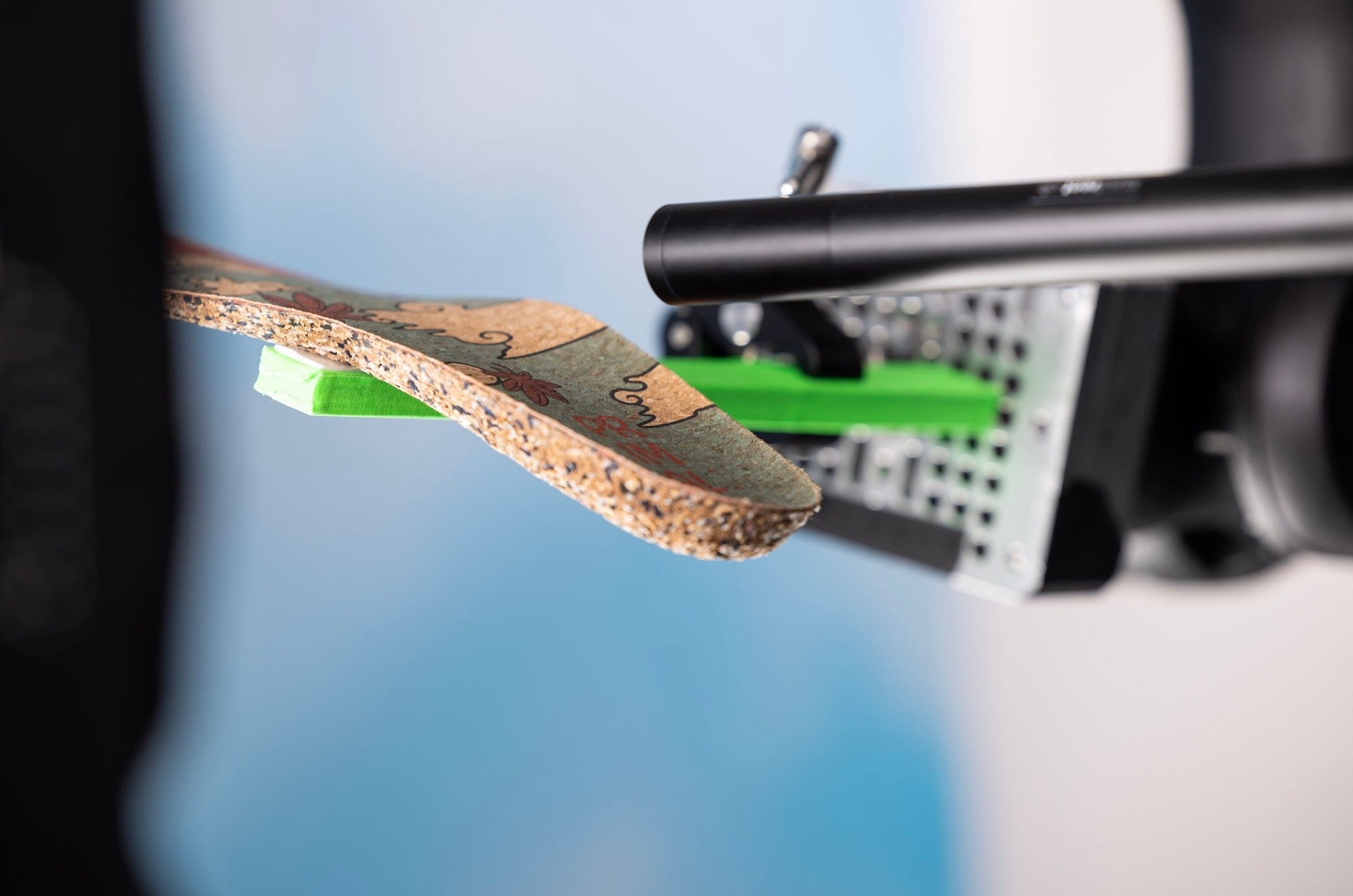According to the Journal of Foot and Ankle Research, 67% of adults experience discomfort in their feet at least once a month. And 33% experience discomfort in their feet at least once a week. If you’ve ever experienced discomfort yourself, you know how quickly it can turn walking from an adventure into a chore. At Primal Soles, we want you to run, jump and hike without limitations. That’s why we make cork insoles for people that want to walk on clouds.
But what makes cork insoles so comfy? Well, to answer that question, we need to look into the scientifically proven causes of discomfort in the feet. In this blog, we’ll do exactly that, before explaining what science says about cork insoles and about improving comfort in your feet. Let’s put on our comfiest lab coats and dive right in!

What causes discomfort in the feet?
Discomfort in the feet can be caused by several factors. In 2008, the Journal of Foot and Ankle Research released a study on the prevalence of foot pain. Overall, 21.6% of the people experience foot pain, with 24.6% being women and 18.6% being men.
The main factors related to footwear were wearing heels, tight shoes and walking barefoot. In most of the cases, the people who suffered from foot pain reported pains in the hips and ankles as well. That’s because a lack of support in the feet leads to imbalances throughout the body. So if you’ve been suffering from pain in your knees or hips, the cause might be that your feet need some extra support.
Having uncomfortable feet isn’t only annoying. It can sometimes lead to serious health issues like flatfeet, bunions, hammertoes, and fallen arches. In the worst case, you can develop plantar fasciitis or Morton’s neuroma. So fixing discomfort in your feet is not an overindulgence. It can actually save you a lot of money and pain over the long term.

What makes footwear feel comfortable?
Well, “Footwear comfort: a systematic search and narrative synthesis of the literature” highlights that comfort in footwear is often associated with characteristics like good fitting, softness, flexibility, and lightness, as well as thermal properties such as breathability. These are also the core characteristics of Primal Soles. Because we know. When you walk comfortably, you explore more. Who doesn’t want that?
In this paper, the authors name 26 studies that show that insoles generally improve comfort in various footwear types. However, results vary due to different populations and insole designs. Softer, more flexible insoles are perceived as more comfortable. But, comfort decreases if insoles make shoes too tight.
So, the perfect insole has a good fit, soft feel and is flexible and lightweight. And the insole should be breathable and thermally regulating. Sound familiar? That’s basically a pair of Primal Soles. But let’s find out if cork insoles are scientifically shown to be more comfortable.

What does science say about cork insoles and improving comfort in your feet?
Cork insoles are often described as one of the most comfortable types of insoles. This is because of the following characteristics:
- Natural shock absorption: Cork has a unique cellular structure. This so-called honeycomb structure allows it to compress and rebound, providing excellent shock absorption. This can help to reduce the impact of walking, running, and jumping, which can cause pain and discomfort in the feet.
- Breathability: Cork is a naturally breathable material, which helps to keep the feet cool and dry. This is important because sweat can irritate your skin and make foot conditions worse.
- Adaptability: Cork insoles can adapt to the shape of the foot, giving you a personalized fit that gets rid of discomfort.
- Biocompatibility: Cork is a biocompatible material, which means that it is unlikely to cause skin irritation or allergies.
- Odor resistance: Cork is naturally odor-resistant, which can help to prevent foot odor and promote overall foot health.
- Sustainable material: Cork is a renewable and sustainable resource, making it a more environmentally friendly choice than other types of insoles.
Cork Insoles And Plantar Fasciitis
A study in the Journal of the American Podiatric Medical Association found that cork insoles significantly reduced plantar pressures in individuals with plantar fasciitis, a prevalent condition causing pain in the heel and arch. This is why people with plantar fasciitis often choose Primal Soles to combat this painful condition.
Cork Insoles And Metatarsalgia
Another condition that can increase your discomfort is metatarsalgia. This condition causes intense pain in the ball of the foot. However, a study by the Journal of Clinical Podiatric Medicine and Surgery revealed that cork insoles significantly reduce pain and improve pressure distribution in individuals with metatarsalgia.
Cork Insoles And Hyperhidrosis
Maybe your discomfort doesn’t come from the above. For countless people, sweaty feet can be a problem. But the solution to sweaty feet doesn’t have to be complicated. The Journal of Athletic Training compared standard and cork insoles and found that cork insoles reduced sweating and improved comfort in individuals with hyperhidrosis, or excessively sweaty feet.
Cork Insoles and Warm Feet
And even if you don’t have an underlying condition, everyone’s feet become uncomfortable when it’s too hot in your shoe. That’s why the thermally regulating properties of cork are loved by our customers. The Journal of Biomechanics discovered that cork insoles make it easy for people to regulate their foot temperature. So no more sweaty stuffy feet when you’re wearing Primal Soles.
So, in conclusion, Primal Soles make your shoes comfier than they already are. We make the only 100% recyclable cork insoles in the market in accordance with EU regulations. The entire production process is carbon negative. And we have a program in place that makes recycling them effortless for you. Because over time and after lots of exploring, your comfy insoles will wear out. But we’ll always be there, at the end of the path, to give your feet the support they deserve.
So, why not try Primal Soles? We make insoles for flat feet and insoles for high arches. Or try our brand-new line, with a design based entirely off the feedback of thousands of users— Primal Clouds. Because they feel like walking on clouds.
Let nature support you. And support nature back.
 Sanjay Ghosh is a sustainability copywriter, and he never walks anywhere without a pair of Primal Soles. With a focus on sustainable topics, he helps make the world a bit greener one blog at a time. Find out more on his website.
Sanjay Ghosh is a sustainability copywriter, and he never walks anywhere without a pair of Primal Soles. With a focus on sustainable topics, he helps make the world a bit greener one blog at a time. Find out more on his website.
Costa, R., Oliveira, A., & Soares, A. (2011). Effect of cork insoles on foot temperature and comfort in healthy individuals. Journal of Biomechanics, 44(12), 2325-8.
Foti, T., Deitch, JR., & Deitch, E.A. (2015). A comparison of the effects of standard and cork insoles on foot sweating and discomfort in individuals with hyperhidrosis. Journal of Athletic Training, 50(5), 600-4.
Hill, C.L., Gill, T.K., Menz, H.B., & Taylor, A.W. (2008). Prevalence and correlates of foot pain in a population-based study: the North West Adelaide health study. Journal of foot and ankle research, 1(1), 2.
Keenan, A.M., Drake, C., Conaghan, P.G., et al. (2019). The prevalence and impact of self-reported foot and ankle pain in the over 55 age group: a secondary data analysis from a large community sample. J Foot AnkleRes, 12, 53. https://doi.org/10.1186/s13047-019-0363-9
Leardini, A., Caraffa, A., Muzzi, G., & Mariani, P. (2009). Evaluation of the effects of cork insoles on plantar pressures in individuals with and without plantar fasciitis. Journal of the American Podiatric Medical Association, 99(5), 405-12.
Menz, H.B., & Bonanno, D.R. (2021). Footwear comfort: a systematic search and narrative synthesis of the literature. J Foot Ankle Res, 14, 63. https://doi.org/10.1186/s13047-021-00500-9
Patel, R.K., Johnson, K.A., & Landorf, K.B. (2012). The effect of cork insoles on foot pain and pressure distribution in individuals with metatarsalgia. Journal of Clinical Podiatric Medicine & Surgery, 28(3), 254-61.
"The Cost of Foot and Ankle Care in the United States" by the American College of Foot and Ankle Surgeons (ACFAS), 2021.
"The Economic Burden of Foot and Ankle Disorders in the United States" by the American Orthopaedic Foot & Ankle Society (AOFAS), 2020.
"Estimated Charges for Selected Medical Procedures" by the Centers for Medicare & Medicaid Services (CMS), 2023.
"The Impact of Foot Pain on Productivity: A Cost-of-Illness Analysis" by the Workplace Health and Safety Institute, 2022.


